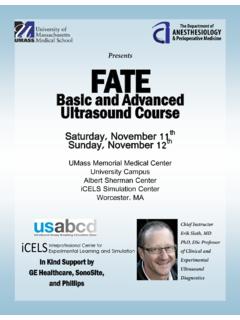Transcription of Introduction to Confocal Laser Scanning Microscopy (LEICA)
1 Introduction to Confocal Laser Scanning Microscopy ( leica ). This presentation has been put together as a common effort of Urs Ziegler, Anne Greet Bittermann, Mathias Hoechli. Many pages are copied from Internet web pages or from presentations given by leica , Zeiss and other companies. Please browse the internet to learn interactively all about optics. For questions &. registration please contact . Confocal Laser Scanning Microscopy xy yz 100 m xz 100 m xy yz xz thick specimens at different depth 3D reconstruction Types of Confocal microscopes {. {. {. point Confocal slit Confocal spinning disc Confocal (Nipkov). Best resolution and out-of-focus suppression as well as highest multispectral flexibility is achieved only by the classical single point Confocal system ! Fundamental Set-up of Fluorescence Microscopes: Confocal vs. widefield Confocal Widefield Fluorescence Fluorescence Microscopy Microscopy Photomultiplier Laser detector Detector pinhole aperture CCD.}}}
2 Fluorescence Dichroic mirror Light Source Light source Okular pinhole aperture Fluorescence Filter Cube Objectives Sample Plane Z Focus Confocal Laser Scanning microscope - set up: The system is composed of a a regular florescence microscope and the Confocal part, including scan head, Laser optics, computer. Comparison: Widefield - Confocal Y. X. Higher z-resolution and reduced out-of-focus-blur make Confocal pictures crisper and clearer. Only a small volume can be visualized by Confocal microscopes at once. Bigger volumes need time consuming sampling and image reassembling. Comparison: Widefield - Confocal optical resolution in z Widefield 2 - 3 m Confocal m Comparison: Widefield - Confocal region of out-of-focus- information Widefield blurred &. large Confocal very small Widefield: optical section Many signals can not be seen separately! Side view Signals on top of each other can not be seen separately Optical section Top view Confocal : optical section Improved z-resolution allow for more accurate signal discrimination!
3 Side view These structures are not superimposed Optical section Top view Confocal : extended focus . Side view single optical sections get projected on one plane - the result is an clean image: everything is focused over the hole depth without any out-of-focus-noise. Projection (Top view): Information content of all the sections is projected to one plane. Z galvo stage provides fast z stacking ! Pivot-mounted arm with galvo motor ! 166 m-z-range on SP2. mm-z-range on SP5. ! fast motor allows live xz-imaging ! Reproduceability 40nm ! Different inserts possible Z-stacking Defining a volume: Setting the z-values for begin & end of the sampling Defining the resolution: defining the thickness and number of optical sections within the volume Aquisition of 3D data sets A= xy top view B, C = xz side views at different y-positons The number of optical sections defines the z- resolution in the data set.
4 The section thickness together with the xy-pixel dimension defines the voxel size (voxel =. volume element, the smallest unit of the sampled 3D volume). Consequences for the Confocal image Cell culture Cellular structures can be resolved due to the good resolution in z Tissue Only a very thin layer through the tissue is visualized. Image aquisition from different sample depths A tissue section was optically sectiones every 10 m. On each section a different situation in the very same tissue context can be imaged. Deep Penetration into a thick sample Thick specimen (100 m): GFP muscle fibers, embedded in Glycerol (80/20). match mismatch center section center section o o z z Glycerol Objective PL APO Oil Objective PL APO Glycerol immersion allows deeper penetration into the sample without severe light loss or distortion. Oil immersion is ideal for imaging near the cover glass.
5 Immersion media and depth penetration cover glass (z=0). Z. 10 M FITC in Glycerol-Water (80/20)-xyz-series 120. 100. 80. %. Oil Glycerol Intensity 60. 40. Beads 220 nm embedded in Glycergel. 20. 0. Glycerol-objectivs allow for deep penetration 0 50 100 150 200 250 300. Depth !m into the embedded biological sample GlycCorr Oil (distortion, brightness). Effect of immersion media on sperical aberration Spherical aberration 9. is one of the most commonly Air observed Longitudinal diameter ( m). problems in 6. Confocal Microscopy < Oil ! Glycerol 3. 0. 1 refractive index Side view (xz plane) of the m fuorescent microsperes embedded in different media with known refractive indices. The speres immersed in oil appear to be more sperical than the others. Specifications of the objective -> need for cover glass thickness ( 0,17 mm), immersion medium (air, water, oil, glycerol).
6 -> abilities for working distance (sample thickness), NA (signal brightness), magnification (field of view). -> resolution power in XY & Z (-> optical section thickness). z - resolution in Confocal Microscopy Optical sectioning thickness Optical sectioning thickness as a function of NA of the objective versus Confocal pinhole diameter Z1/2 ( m). Z ( m). Immersion Oil n= Air n=1. 0 NA Pinhole diameter (mm). Confocal imaging - in focus/out of focus ex em Pinhole diameter effects opt. section small pinhole diameter: big pinhole diameter: -> thin optical section -> thick optical section = high z-resolution possible = low z-resolution = low signal strength = brighter signal Pinhole size, color and z-resolution The pinhole is optimized for each objectiv. m Airy 1 is a good start, but NOT an iron rule; play with pinhole to get either more light or more resolution.
7 Resolution depend also on wavelength; keep in mind if resolution REALLY matters. leica pinhole values are optimized for medium wavelength. m The pinhole variable determines your z-resolution. The single point Confocal system Beam diameter is limited by a pinhole aperture -> field of illumination & detected signal are pointed ! consequences for Confocal imaging: The illumination intensity has to be very high. ( Laser light). Photo multipier tubes (PMT) are used for sen- sitive and fast single point intensity registration. The light source is scanned over the sample. The image has to be rebuilt from the recorded point intensities according to the xy- coordinates. The image is not directly visible for the eye. The image has to be electronically generated. (Sequential acquisition process). Laser as Confocal light source Mercury and Xenon Light sources are to week for point Confocal systems.
8 Strong bundled light is generated by LASERS. There are different types of LASERS: Argon, Argon-Krypton, Helium- Neon, etc. The coupling to the system and the alignment has to be done by trained engineers. Laser sources generate monochromatic light of a discrete wavelength -> Laser line . For the spectral range are different LASERS necessary. Depending on the hardware of the microscope, some of the following lines might be available (" in nm): 352, 364, 405, 430, 458, 476, 488, 496, 514, 543, 561, 596, 633. Laser Excitation 561 nm 543 nm 514 nm Laser Laser Laser . Alexa 568 Alexa 568 Alexa 568. ! choose florochromes accordingly to the Laser lines: as further away the Laser line is from the absorption maximum of a fluorochrome as weaker the emission signal gets! The filter free CLSM: leica confocals Non- leica : glas filters and dicroic mirrors determine the spectral detection leica : Prisms, free adjustable barriers and tunable quarz cristals determine the spectral detection: AOTF, AOBS, SP.
9 leica TCS SP5*. -the newest generation of leica Confocal microscopes *The ZMB owns an inverted leica TCS, a TSC SP2 Confocal system with up-right and inverted microscope stand and an inverted leica TCS SP5. leica Confocal Laser Scanning microscope Light source (Lasers, AO TF). Filters (SP). Detectors (PMT, APD). Beam splitters (AO BS). Scanner (conventional, resonant). AOTF Acousto Optical Tunable Filter Ultrasonicabsorber Incident Laserlight Diffracted Laserlight Fiber Acousto Optical Crystal Undiffracted Laserlight Ultrasonic Source This adjustable quartz filter works at frequencies as high as sound, that is "Acousto-".! => Light, which passes the AOTF, is diffracted depending on ist own wavelength and the wavelength of the ultrasonic wave field. The ultrasonic wave field can be modulated, so that the intensities of the different Laser lines can be changed between 0% and100% by the software even during the Scanning process.
10 AOTF Acousto Optical Tunable Filter 458 nm Argon Laser 476 nm The AOTF enables you to AOTF 488 nm select the wavelengths 496 nm ( Laser lines on/off). 514 nm The AOTF enables you to control the intensity of the excitation light. Excitation optimum Fluorophore Saturation 1. Saturation 0. +00 +24 +24 +24 +25 +25. Excitation Photons ex ex < Avoid oversaturation ! -> lower light power decreases phototoxicity and bleaching. #. # em em leica Confocal Laser Scanning microscope Light source (Lasers, AO TF). Filters (SP). Detectors (PMT, APD). Beam splitters (AO BS). Scanner (conventional, resonant). spectral detection in leica CLSM. The leica spectrophotometer detection Prisma and system (SP): After passing the detec- adjustable tion pinhole, the light emitted from the barriers focal plane is passed through a prism, allow free which stretchs the emitted light.









